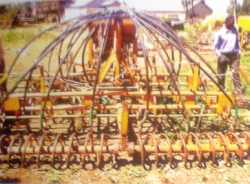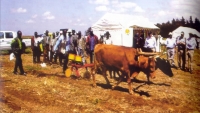Conservation Agriculture: Hope for Africa's Farmers?
Conservation Agriculture for Sustainable Agriculture and Rural Development (CA-SARD) project is one of the five case studies about conservation agriculture in Kenya, Tanzania, Ghana, Uganda and Zambia developed in collaboration with Centre International de Recherche Agronomique pour le Development (CIRAD), Food and Agriculture Organization (FAO), Regional Land Management Unit (RELMA) and the African Conservation Tillage Network (ACT). The second Phase of this project in Kenya is under the Ministry of Agriculture’s Kenya Agricultural Research Institute (KARI). It involves other stakeholders such as Jomo Kenyatta University of Agriculture and Technology (JKUAT). Purity Njeru of The African Executive talks to Crispus Mugambi, a KARI researcher, about the project.
Purity: What is Conservation Agriculture (CA)?
Pneumatic direct planter
Crispus: CA is a resource-saving agricultural production method that is profitable, sustainable and also conserves the environment.It involves minimal soil tillage and use of agro-chemicals. Nutrients of organic or mineral origin are applied in quantities that do not interfere with or disrupt the soil’s biological processes.

Purity: Briefly tell me about the project
Crispus: CA-SARD Project Phase II was initiated in March 2007 based on the lessons learnt and recommendations made from the project’s first phase that lasted for two years. It focuses on promoting intervention practices such as zero tillage, availing CA equipment, training of artisans and forging links with the private sector.
Purity: What was involved in Phase 1?
Crispus: Phase I involved description of bio-physical, social economic and institutional environment in project study sites through participatory rural appraisals, focus group discussions and questionnaires. CA technologies that suit the study areas were investigated through on-station or on-farm experimentation; past study reviews; farmer meetings; and evaluation of the activities for assessing impact and adoption.
Purity: Where are you basing the second phase in Kenya?
Crispus: The second phase will be based in 5 districts in Kenya that is, Laikipia, Siaya, Bungoma, Nakuru and Mbeere. Farmers involved in the project will be grouped into Farmer Field Schools (FFS) and practice CA for one to four seasons. FFS formation will accord farmers a chance to experiment with the CA technologies and reflect on the various merits of the technologies and make decisions on the need to adopt them.
Gains from these studies will be used to demonstrate the usefulness of CA towards broad-based agricultural growth and development, especially in Kenya (and Sub Saharan Africa) where 70 percent of the population is anchored in agricultural activities.
Purity: What farming tools does CA employ?
Crispus: Seeds are planted with jab planters or animal/tractor drawn direct planters, animal drawn sub-soilers (for fields with hard pans) magoye rippers (for water harvesting) and pull sprayers (for applying herbicides) before planting. These machines cause minimal soil disturbance. A jab planter jabs the soil and injects both seed and fertilizer into the planting holes.

Animal drawn direct planter
Purity: Who else is involved in the project?
Crispus: Local artisans around the villages will play a critical role in repairing broken farming equipment. They will be trained on care, maintenance and repair of the CA equipment. Engaging the artisans is also envisioned to stimulate innovativeness hence opportunity to develop similar or better equipment suited to each unique environment or farming needs.
Purity: What’s the economic advantage of CA from other forms of Agriculture?
Crispus: Labor intensive production costs incurred in such practices as harrowing, weeding, and fallowing among others are not incurred. Furthermore, CA reduces incidences of weeds and pests and improves water infiltration into the soil thereby increasing harvest compared to conventional agriculture.
Purity: Aren’t the equipment expensive?
Crispus: They are. However, farmer grouping via FFS encourages pooling together of resources to facilitate equipment acquisition. Once the inputs are acquired, farmer groups can hire them out to other interested farmers in their localities at a small fee that can enable re-couping of the purchase costs over time.
Purity: How long will the project take?
Crispus: The second phase will take three years (2007 to 2010).
Purity: What benefits does this project have?
Crispus: Farmers increase their production as better soil management reduces loss of soil fertility; the environmental is conserved as less exposure of soil reduces emission of Green House Gases and dust particles. Research findings by students engaged in the project will be used to lay a policy framework for CA in the country and strategize future CA research themes.
Purity: What is the organization doing to help prepare farmers embrace this technology?Crispus: The project will be coordinated by KARI, whose personnel will play a crucial role in facilitating the formation of FFS, developing training curricula on various CA technologies and also organizing sensitization campaigns geared at informing farmers on the various benefits of CA practices.
